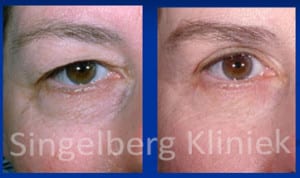Eyelid correction, blepharoplasty
Eyelid surgery, or blepharoplasty, is an operation that corrects sagging, or drooping eyelids as well as bags and bulges around the eyes.
These conditions develop as a result of laxity of the eyelid skin and protrusion of fat around the eyes. It is not limited to older patients, as many individuals inherit a predisposition toward development of fat pouches at an early age.
Excess skin is treated by excision or occasionally by laser resurfacing. If excess fat is present, it can be removed simultaneously. Care must be taken to not remove excessive amounts of fat to avoid a hollowing appearance with increasing age of the patient.
Some people suffer from eyebags, caused by pseudohernias of fat (which is fat pushing through the wall of the eye muscle) at a young age. This tends to be hereditary (an inherited condition from within the family) and can be corrected with a lower eyelid blepharoplasty.
Blepharoplasty, however, cannot remove dark circles under the eyes caused by dark pigmentation of the skin or by very thin, translucent (“see-through”) skin. It does not smooth fine lines and wrinkles around the eye or “crows’ feet”. It cannot lift sagging eyebrows either. Low eyebrows can only be raised in a browlift operation. Because of individual factors, not everyone will achieve the same results from eyelid surgery.
Your plastic surgeon will select the surgical technique that he or she feels will obtain the best outcome for you.
Eyelid Surgery in Belgium
The operation is generally performed under a local anaesthetic, but some patients are given sedation via an intravenous drip. In rare cases, a general anaesthetic can be used.
Upper eyelid blepharoplasty involves cutting along the eyelid crease, in the natural skin fold of the eyelid. The cuts for both upper and lower lid procedures can be made with either a surgical scalpel or a laser. N.B. Surgeons who use a laser claim that there is less bleeding and fewer bruises after the operation as the laser seals the blood vessels when it cuts into the skin. Then, excess skin is removed and a thin strip of muscle is also taken out to give the eyelid crease more shape. Next, unwanted fatty tissue is removed and the cut is then closed with a single layer of stitches, hiding the scar inside the natural fold of the upper eyelid. Because the incision follows the natural contour of the upper eyelid, it will be well camouflaged when healed.
The two most common methods of performing lower eyelid blepharoplasty are: For lower eyelid surgery, often an incision is hidden just below the lower lashes. Through this incision, excess skin, muscle and fat are removed, or fat may be redistributed to eliminate puffiness or bulges.
Other adjustments to correct special problems such as muscle laxity may be performed. As in upper eyelid surgery, the incision is well camouflaged by natural creases. A technique called transconjunctival blepharoplasty may be used if you have a pocket of fat beneath your lower eyelids, but do not have any loose skin. It is usually performed on younger patients who have fat pads that push out through the eye muscle wall into their lower eyelids.
The transconjunctival method leaves no obvious scars. The cut is closed with self-dissolving stitches or is left to heal naturally. In addition to this surgery, a lid tightening procedure may be recommended and can be performed at the same time. A blepharoplasty operation takes about 1 to 2 1/2 hours for the upper and lower lids on each eye to be treated. If you are having another procedure, such as a facelift, at the same time, then an overnight stay in hospital may be required.
Otherwise, patients can usually go home after eyelid or eyebag surgery on the same day as their operation. Most patients find that they are ready to go out in public and be seen in around a week to 10 days following this procedure. Most of the swelling and bruising will have subsided after this period of time.
Conclusions
Eyelid surgery or “blepharoplasty” treats drooping or fullness of the upper or lower eyelids. As men and women age, their upper eyelids tend to sag and their lower eyelids tend to become puffy. These developments can lead to a tired and older appearance. Blepharoplasty uses small incisions that are hidden within natural skin folds. Various amounts of excess skin, fat and muscle are removed. Scars are usually almost imperceptible. Sometimes the lower eyelids can be treated using incisions made on the inside of the lower eyelid, with no external scars, in a procedure called transconjunctival blepharoplasty. At Rodeo Drive Plastic Surgery, we tailor our eyelid surgery to the needs of each individual patient.
Though these procedures usually only last one to two hours, the improvements in appearance are often dramatic.
